|
79. Aphantopus hyperantus (Linnaeus, 1758) / Ringlet / Nymphalidae – Satyrinae
NL: koevinkje / D: Grasfalter, Schornsteinfeger, Brauner Waldvogel / F: Tristan
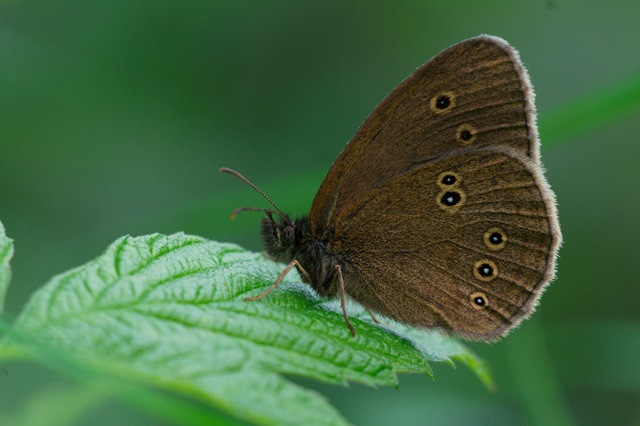   Photographs: Jeroen Voogd, Frits Bink, Jeroen Voogd ©. Photographs: Jeroen Voogd, Frits Bink, Jeroen Voogd ©.
Medium-sized, wing length 21 (18-24) mm. The species occurs in all countries of the Benelux in gradient between wood or shrub and grassland, mainly in the countryside. It prefers shaded, humid and cool sites and is often the only ‘brown’ butterfly present at a site.
Butterfly on the wing from mid-June until early-August, peaks early-July. The species is known from maritime and continental climates, amplitude 4 to 18. Required heat sum 400°d, maximum tolerated 1800°d, corresponding climate windows 19 and 35 weeks.
In England the species disappeared from many sites due to the hot and dry summer of 1976 and it took seven years to recover (Asher et al. 2001: 279). In the Netherlands, it has extended its distribution into the dunes since 2000 (Bos et al. 2006: 227-228).
Ecological characteristics
Behaviour over time
Overwintering: small larva in third instar, hidden in tussock of the host-plant.
Reproduction: oviposition starts after 3-5 days when the body contains about 90 eggs, potential production 2.1 times as much. Female produces 24 (19-30) eggs per day.
Larval feeding periods: in summer 66 (55-78) days from end-July until end-October and in the next spring 81 (72-90) days from mid-March until mid-June.
Generations: one.
Spreading of risk: not observed.
Life cycle: egg 16 (13-20) days; larva 43-47 weeks; pupa 18 (14-28) days.
Life span of adult: rather long, 3 weeks.
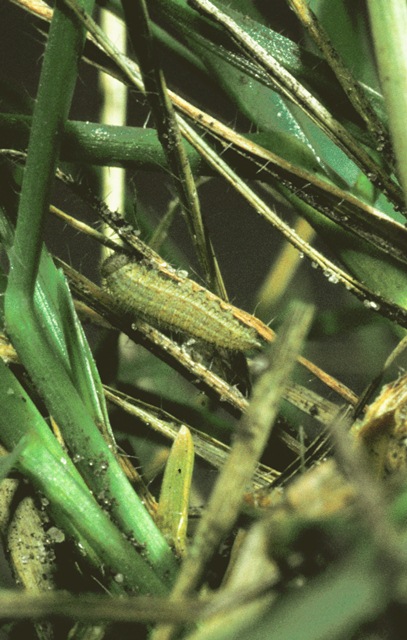 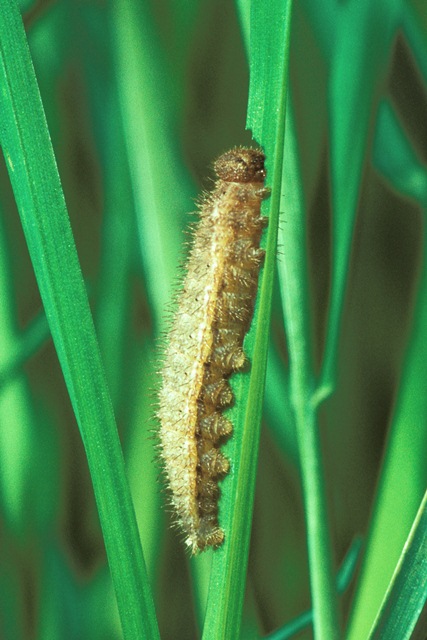
Photographs: Frits Bink ©.
Behaviour in space
From stay-at-home to migrant: stay-at-home, spatial requirement modest, some individuals migrate long distances.
Finding a mate: male patrols but also aggregate together with females on a flowering bush.
Orientation in the landscape: gradient between tall grass and bush.
Oviposition: female drops the eggs when basking or drinking.
Defence
Threats from other organisms: larva lives hidden in the thickest part of the vegetation.
Threats from the environment: hibernating larvae survive well in permanently wet conditions.
Feeding habits
Adult: nectar of all kinds of flowers, frequently seen on flowering bramble.
Larva: no signs of basking or preferred leaf quality.
Larval foodplants
Plant species: Poaceae, e.g. Alopecurus pratensis, Cynosurus cristatus, Dactylis glomerata, Elymus repens, Phleum pratense.
Journal
Rearing experiment based on specimen from Leersum, Zuylenstein, Netherlands:
6 July 1986: females captured at a ride in a copse, in the afternoon the first eggs were dropped.
23 July: eggs hatched.
1 August: seven larvae, one freshly hatched.
31 August: all larvae equal in size, 4.5 mm in length, looked like second instar, all were feeding.
21 September: larvae 5 mm in length, some were still feeding.
13 October: larvae with empty digestive tracts, in diapause.
Overwintered outdoors.
10 March 1987: all larvae were feeding, three were in third instar, four in fourth.
20 April: biggest larvae nearly fully grown.
1 May: larvae in stage L5.
20 May: larvae fully grown.
5 May: one pupa, one larva still feeding.
23 June: two adults appeared.
Table 79-1. Results of dissections

Table 79-1a. Oviposition sequence

Table 79-2. Collection and observation localities
D, Borkener Paradies 52° 43’ 29”N – 7° 14’ 36”E; 9 July 2002.
D, Lorch, 300m, 50° 02’ 05”N – 7° 47’ 56”E; 31 July 1985.
D, Steigerwald, 49° 39’N – 10° 23’E; 24 July 1984.
DK, Gundersted 56° 55’ 08”N – 9° 26’ 31”E; 10 July 2005.
DK, Lundby 56° 55’46”N – 9° 29’ 43”E; 8 July 2005.
DK, Tofte Mose 56° 49 16”N – 10° 16’ 08”E; 4 July 2005.
DK, Ørnhej 56° 13´ 06”N – 8° 34´ 00”E; 14 July 2005.
EST, Kuresoo, 58° 28’ 00”N – 25° 11’ 59”E; 8 July 1999.
EST, Valge raba 58° 26’ 29”N – 25° 14’ 09”E; 8 July 1999.
EST, Viruna 58° 28’ 51”N – 23° 58’ 32”E; 5 July 1999.
EST, Endla Nature Reserve, 58° 52 34”N – 26° 16’21”E; 10 July 1999.
EST, Pööravere 58° 40’ 25”N – 24° 36’ 50”E; 16 July 1999.
F, Lorraine, Dieue-sur Meuse 49° 05’ 11”N – 5° 27’ 25”E; 11 July 1984, 19 August 1984, 10 July 1985.
F, Lorraine, Jaulny, 209 m, 48° 57’ 55”N – 5° 52’ 52”E; 29 June 2002, 8 July 2006.
F, Lorraine, Lion-devant-Dun, 300 m, 49° 23’ 40”N – 5° 14’ 03”E; 10 July 1985.
F, Lorraine, Rupt devant Saint-Mihiel, 280 m, 48° 53’ 01”N – 5° 24’ 10”E; 28 June 2006.
F, Montmédy, 217 m, 49° 31’ 07”N – 5° 21’ 33” E; 12 June 1984, 18 August 1984.
F, Velosnes, 179 m, 49° 30’ 09”N – 5° 27’ 27”E; 19 August 1985, 28 June 2002.
F, Vosges, Hohneck 1283 m 48° 02’ 03”N – 7° 02’ 27”E; 23 July 1983, 22 August 1984.
F, Vosges, le Zinnkoepfle, 481 m, 47° 57’ 56”N – 7° 15’ 08”E; 10 July 1984.
GB, Oxford, Great Wood 51° 41’N – 0° 55’W; 20 July 1981.
NL, Bennekom, de Kraats 52° 00’ 20”N – 5° 38’ 04”E; 3 July 2014.
NL, Haaksbergen, Harrevelderschans 52° 08’ 59”N – 6° 46’ 45”E; 5 July 2003.
NL, Leersum 52° 00’ 29”N – 5° 24’ 04”E; 22 July 1980, 8 July 1986.
NL, Schuitwater 51° 28’ 35”N – 6° 07’ 43”E; 8 July 2003.
S, Gotland Buttle 57° 25’ 09”N 18° 34’ 38”E; 16 July 2004.
S, Gotland, Grogarns 57° 25’ 32”N – 18° 53’ 21”E; 14 July 2004.
S, Gotland, Hummelbosholm 57° 11’ 48”N – 18° 32’ 56”E; 8 July 2004.
S, Gotland, Klinteklinten 57° 40’ 14”N – 18° 46’ 26”E; 13 July 2004.
S, Gotland, Lickershamn 57° 50’ 17”N – 18° 34’ 54”E; 3 July 2004.
S, Gotland, Lickershamn 57° 51’ 05”N – 18° 37’ 46”E; 17 July 2004.
S, Gotland, Mallgård Källmyr 57° 19’ 32”N – 18° 17’ 14”E; 20 July 2004.
S, Gotland, Russväter 57° 23 29”N – 18° 43’ 36”E; 21 June 2004, 16 July 2004.
S, Gotland, Stygmyr 57° 50’ 10”N – 18° 38’ 32”E; 18 July 2004.
S, Gotland, Östergarn 57° 24’ 43”N – 18° 43’ 27“E; 15 July 2004.
S, Öland, Frösslunda 56° 32’ 34”N – 16° 35’ 12”E; 22 July 2004.
S, Öland, Stenåsa 56° 32’ 44”N – 16° 36’ 43”E; 21 July 2004.
Fig. 79-1. Aphantopus hyperantus, phenogram adapted from Fichefet et al. 2008: 167.

Fig. 79-2. Aphantopus hyperantus, habitat characteristics.
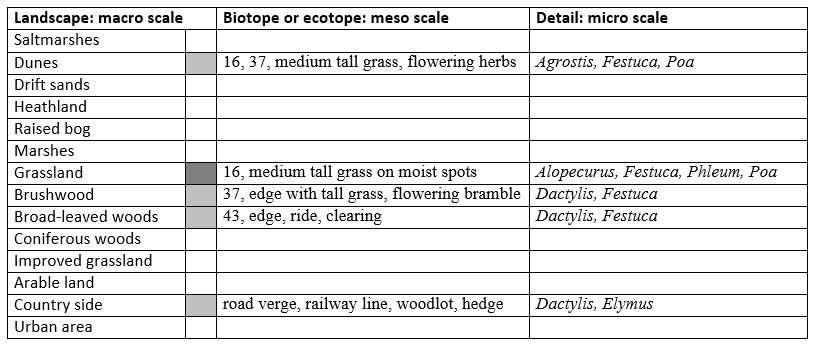
Fig. 79-3. Aphantopus hyperantus, climate matrix, heat-sums 400 - 1800°d.
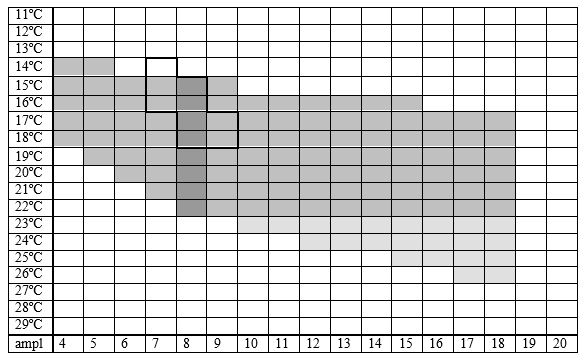
|











